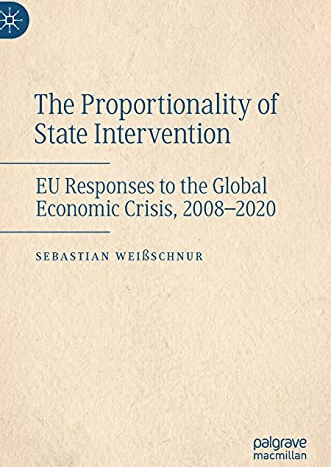The Proportionality of State Intervention
EU Responses to the Global Economic Crisis, 2008-2020
ISBN 978-3-030-75675-8
Written for lecturers, political advisors and students of economics and fiscal policy about the principles of proportionality of state intervention and modern monetary and economic strategies of the European Union. Explore causes and effects of European financial crisis decisions, various market intervention options for EU governments and potential strategies for economic growth.
Available in select universities and libraries worldwide
Topic Overview
-
State Intervention & Principle of Proportionality
The main theories of state intervention and the Principles of Proportionality and Subsidiarity are critically appraised in this chapter. Neofunctionalism, intergovernmentalism and postfunctionalism are the three theories of state intervention discussed, followed by an overview of the nature of state intervention in planned and free market economies. The EU is described as a liberal free market based on neoliberalism principles, in which capitalism, democracy and liberalism are combined. Neoliberalism is then examined in terms of underlying theories of Public Choice and Rational Choice followed by the concept of proportionality, its theoretical origins, practical application and links to Justice Theory. An overview of EU intervention after the 2007–2008 financial crisis, and its impact on Member States, is presented at the end of this chapter.
Theories of European Integration
- Neofunctionalism
- Intergovernmentalist Theory
State Intervention by EU
- Postfunctionalism
Theories Underlying Rise of Neoliberalism
- Public Choice Theory
- Rational Choice Theory
The Concept and Definition of Proportionality, Theoretical Roots and Practical Applications
- Justice Theory
The Nature of State Intervention in the Post-crisis Developed World
- Financial Reforms
- Financial Stabilisation
- Enhancing Economic Governance
- Generating Economic Growth
- The Economic Recovery Plan (ERP)
Outline of the Impact of State Intervention After 2008
- Economic Impact
- Social Impact
-
Global Economics Before and After the 2007 Economic Crisis
The major events that occurred in the decades prior to the 2007–2008 crisis are appraised including the emergence of securitisation, substantial changes in regulation that created freer financial markets and high market liquidity. The impact of the crisis which resulted from these changes is evaluated in relation to its severe financial effects on the banking sector in US and EU countries, the social effect of public loss of trust and new EU legislation to prevent taxpayers being responsible for bailing out Member States’ failing banks. The last two sections of this chapter evaluate the severity of the crisis generally, and in relation to specific groups of EU Member States, Northern Europe, Portugal, Ireland, Italy, Greece and Spain (PIIGS), and Eastern Europe.
Events Leading to the 2007 Global Recession
- Origins of the Factors and Initial Symptoms
- Historical Infuences
- Securitisation
- Mortgage-Backed Securities
- Advantages of SPVs
- Financial Markets Immediately Prior to the 2007 Crisis
- Changing Regulation
- Liquidity
Consequences of the Crisis
- Outline of the Financial Effects
- Economic Effects
- Financial Sector Competition
Crisis Severity
- Overview
- The Crisis in Europe
- Securitisation Trends in EU
- Initial European Reaction
- The EU Crisis Timeline
The Crisis in Different European Countries
- Northern Europe
- Portugal, Ireland, Italy, Greece and Spain (PIIGS)
- Eastern Europe
-
Interventions by Governments
The opening part of this chapter identifies and discusses the main methods that governments employ to intervene in markets: monetary and fiscal policies and intervention in banks. The role of the Principles of Proportionality and Subsidiarity in the manner that EU intervenes in markets is appraised prior to a review of the details of its intervention by application of the three principal methods. Monetary and fiscal policies are discussed in respect to the 17 Member States comprising the Eurozone, which were the EU’s major concern after the 2007–2008 crisis, and monetary policy impacting on all 27 Member States, which relies on European Central Bank (ECB) coordination with national central banks. Fiscal discipline was regarded as more important in Eurozone countries that were subjected to introduction of a range of standard interventions in an attempt to meet specific debt-level criteria imposed by EU.
Options for Government Intervention
- Intervention in Markets
- Market Failure
- Instruments Employed for Government Intervention
- Fiscal Policy Intervention
- Monetary Policies Intervention
- Intervention in Banks
EU Government Intervention
- EU Subsidiarity and Proportionality
EU Government Intervention in the Market
- Monetary and Fiscal Policies
- Setting Monetary Policy
- Fiscal Policy Intervention
- Intervention in Banks
- Intervention by Means of Taxation, Subsidies and Regulation
- Intervention in Labour Markets
-
Overview of EU Responses to the Global Economic Crisis
There are two parts to this chapter: the major EU responses to the 2007–2008 crisis and the diverse effects they had on major Eurozone Member States. The main EU responses appraised are financial reforms, financial stabilisation, enhancing economic governance, funding relating to these measures and interventions to generate economic growth. Identical responses were imposed on all Eurozone members with varying degrees of success, as illustrated by two severe crises in Greece and in Italy. Fundamental differences between the UK and the EU on some policies are discussed as these were instrumental in initiating a referendum on EU membership and the decision by the British electorate to exit.
Overview of EU Response to the 2007–2008 Crisis
- Financial Reform
- Financial Stabilisation
- Enhancing Economic Governance
- Funding the Measures
- Generating Economic Growth
The Major Eurozone Crises 2015 to 2018: Case Studies Greece, Italy and UK
- Greece
- Greece in the Eurozone 2007–2014
- Greek Crisis 2015
- Greece 2018–2019
Italy
- The Threat to the EU and the Eurozone from Italy
The UK: Brexit
-
EU Initiatives
The EU Recovery Plan and the drivers for growth in the EU Single Market for the period from 2008 onwards are the most important subjects appraised in this chapter. The EU Recovery Plan is critically evaluated in respect to regenerating economic growth, and especially related to job creation for under 25-year-olds, which was required owing to the high percentage of youth unemployment especially in the Southern European Member States. The monitoring plan is also evaluated including criticism of its perceived lack of effectiveness by independent experts. The EU Single Market is explored in terms of the stated drivers for growth, the investment plan to accomplish these goals and a specific strategy to enable economic growth in Greece as it received its third bailout, a reflection of the failure of previous EU intervention.
The Economic Recovery Plan
- Plan Details
- EU 2020 Growth Strategy
- The EU Compact for Growth and Jobs and Youth Initiatives
- Monitoring the ERP and 2020 Strategy
- Review of 2020 Targets
- External Assessment of ERP
The EU Single Market
- Drivers for Growth
- Investment for Growth
- Investment for Growth in Greece
-
Effects of Government Intervention
This final part of the original research summarises the main findings and draws conclusions regarding the proportionality of EU intervention in Member States after 2007–2008 including quantifying them from publicly available data. The effects of intervention on unemployment and economic growth are summarised, and found to have had a varied impact across the Members States, with Southern European countries being more negatively affected than northern nations. The influence of austerity measures is evaluated employing evidence from diverse sources, and the EU intervention of a single policy for the economic recovery of all Member States is found to be flawed. The reluctance of EU to consider advice from outside its own advisers, an inability to learn, is identified as a reason for its failure to implement suitable interventions to support reviving the economies of all Eurozone Member States, rather than just those with low initial deficits. The final section demonstrates that the Principle of Proportionality had not been applied appropriately during this period as demonstrated, for instance, by the substantial divergence in the social and economic consequences of EU interventions in Member States and the dominant influence of Germany on EU policy and changes to legislation. The major spillover effects on Eurozone and non-Eurozone members are also summarised.
Overview of the Effects of State Intervention on Employment and Growth
- Unemployment and Economic Growth Trends
- Portugal an Exemplar for Success of Austerity Strategy
- The Beveridge Curve as an Employment Indicator
- Impact of Uncertainty on Unemployment
Intervention Austerity Measures, Problems and Effects
- Economic Cycles, Policies and Effect on Economic Growth
- State Intervention and the Consequent Problems
- Portugal
- Spain
- Italy
- Germany
- Greece
- France
Principle of Proportionality
Spillover Effects of EU Policies
-
Case Studies: The EU in 2020
This chapter compares the economic, social and political development in three of the original EEC Member States from their initial membership until mid-2020. Three case studies undertaken in Germany, Italy and the United Kingdom explore the history prior to 2008, the EU interventions in the post financial crisis period and their consequences on national social and economic trends. Since these three Member States were among the founding members of the EEC, but have experienced diverse experiences and outcomes from the same EU policies, the potential reasons for the difference are explored. The findings from surveys conducted in each of those countries are presented in terms of how aptly the Principles of Proportionality and Subsidiary have been applied in each case. A short epilogue outlines the current situation reinforcing Germany’s continued influence on EU policy and demonstrating the lack of solidarity among EU nations during the Coronavirus pandemic, and the EU response to it.
Case Study 1: United Kingdom
- Background
- UK Relationship with EU from 2008
- Primary Research on UK Case Study
- United Kingdom Survey Analysis and Discussion
- Hypothesis Testing
Case Study 2: Germany
- Background
- German Economic Trends and Relations with the EU from 2008
- Germany and EU
- Primary Research on German Case Study
- German Survey Analysis and Discussion
- Hypothesis Testing
Case Study 3: Italy
- Introduction
- Background
- The Economic Miracle
- Italy Economic Trends Since 2008 Financial Crisis
- Major EU Policy Intervention in Italy Since 2009
- A Third Italian Recession: Impact on Europe
- Primary Research on Italy Case Study
- Italy Survey Analysis and Discussion
- Hypothesis Testing
Case Study Limitations and Outcome
Available in print and digital format
AUTHOR
Sebastian Weissschnur
Sebastian Weißschnur is a shareholder and Managing Director of several companies in Germany, the US and the Emirates, and he has continuously been listed as one of the Top 10 financial advisors (out of more than 100,000) in Germany since 2007. He holds a Bachelor's Degree and a Master's Degree in Business Administration as well as further education in finance and economics from renowned institutions such as Harvard Business School. His research, textbooks and articles have been published by trusted industry brands, such by the prestigious publisher Springer Professional.
Sebastian Weissschnur is an internationally recognized author and economic strategist whose work on state intervention and fiscal proportionality is held in leading institutions such as Harvard, Oxford, Yale, Cambridge and the European Parliament. His research bridges academic rigor and practical strategy, shaping high-level consulting approaches to global finance, governance, and regulatory transformation. His WorldCat entity: Link.
'This is an excellent book providing a comprehensive insight into the state interventions and the EU policies in response to the economic crises that has adversely affected the economies of Europe since 2008. Highly recommended to anyone interested in the socio-economic problems that Europe is facing, the limitations posed by its flawed institutional architect and the challenges ahead.'
Muhammad Ali Nasir
Associate Professor in Economics at the University of Leeds and a Visiting Research Fellow at the University of Cambridge. He is the author of 'Off the Target: The Stagnating Political Economy of Europe and Post-Pandemic Recovery'.
Button'[...] Due to the in-depth and comprehensive research and analysis of the data from 2008 to 2020, this publication can be described as a scholarly work that every expert in the field of finance should take a look at in order to learn about the interrelationships of the financial crisis and the consequences thereof, but also about proposed solutions. [...] The book is rounded off by a large number of case studies, through which one can gain an even deeper insight into the subject matter.'
Michael Hauer, Professor for Financial Markets and Financial Planning
at the ebs European Business School, Oestrich-Winkel and at the Amberg-Weiden University of Applied Sciences.
Button'I had an excellent experience working with Sebastian Weissschnur on his book 'The Proportionality of State Intervention'. I found him highly professional and his ability to communicate his expertise within the field of economics make him a very suitable author.'
Wyndham Hacket Pain, Senior Editor, Palgrave Macmillan
The Proportionality of State Intervention
'Mr. Weissschnur takes a scientifically grounded look at global food speculation. His view of this controversial topic is multifaceted, which distinguishes him clearly from other authors. His recommendations for evaluating prominent non-profit organizations and the use of donations based on new findings from his own survey are intriguing. Excellent!'
Dr. Günther Horzetzky, State Secretary at the German Ministry of Economic Affairs, Energy, Industry, SMEs and Crafts
Fundraising to Combat Hunger Crises
Button
All BOOKS BY SEBASTIAN WEISSSCHNUR:
Globaler Kapitalschutz
(German Edition)
The Proportionality of State Intervention: EU Responses to the Global Economic Crisis, 2008-2020
(English Edition)
Fundraising to Combat Hunger Crises: The Functions and Effectiveness of Non-Profit Organisations
(German Edition)
Financial Products in Times of Crisis of Confidence: Innovative and Demand-Responsive Product Approaches
(German Edition)
Development of a Marketing Strategy using the example of a gastronomic investment project at a Spa Resort
(German Edition)
Promoting Employee Health in a Private-Sector Company in Times of Change Management Based on Salutogenesis
(German Edition)



























